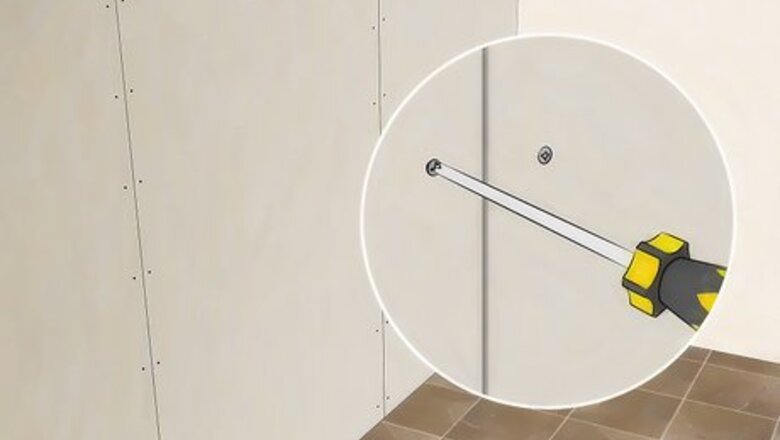
views
Applying the First Coat of Compound
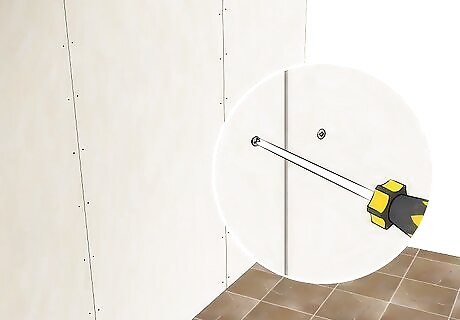
Make sure the drywall is ready to be finished. After the drywall is installed, you should look for any screws that are sitting proud of the wall. Drive them in until they are recessed just slightly. Remove any bits of the drywall's outer paper layer that are torn or loose. This will keep them from becoming mixed into the joint compound and showing.
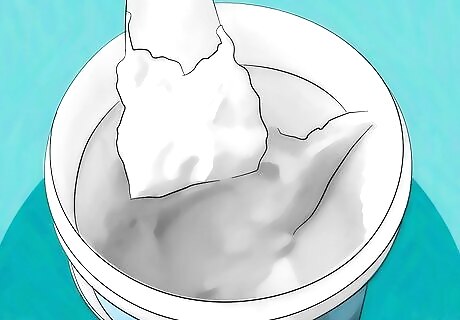
Stir the joint compound. Drywall joint compound (sometimes called "mud") is sold in large buckets. Remove the bucket's lid and check for a layer of water on top of the compound. If water is present, mix the compound thoroughly with a drill fixed with a mixing paddle. If no water is present, mixing is not necessary.

Cover the screws and joints with joint compound. Load your mud box (or any other container you use for holding the joint compound) using a 5-inch (125 mm) drywall knife. Load the knife with joint compound and use it to fill in the gaps between drywall panels. Use the compound to cover exposed screw heads as well. When all joints and screws are covered, pass over the areas with the knife to smooth out the joint compound. The smoother the joint compound, the less work you'll have to do later when you apply a second or third layer of compound.
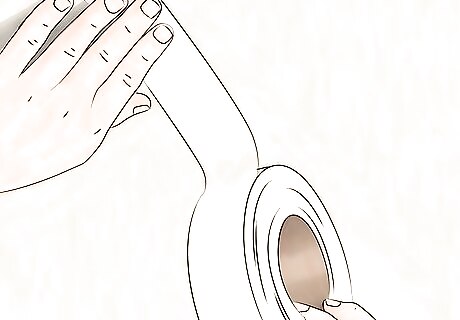
Apply drywall tape to all joints. Unroll a few feet of tape and position the tape over the freshly applied joint compound covering each joint. Gently press the tape into the joint. Unroll more tape and continue covering the joint until you reach the end of the wall. Tear the tape against the drywall knife blade to achieve a clean edge. When taping an inside corner, you should pre-crease the tape. Cut the tape to length first, bending it back on itself to crease it. Apply the tape to the corner by gently pushing it into place with the drywall knife.

Smooth the tape with your drywall knife. Hold the 5-inch knife against the taped joint at a shallow angle. In one continuous motion, pull the knife across the joint, pressing the tape into the compound. Excess joint compound can be scraped off into the mud box.
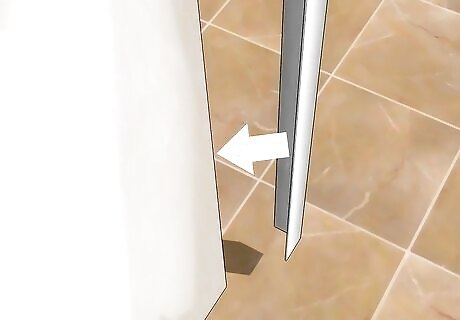
Cover outside corners with joint compound. Outside corners do not require drywall tape, as they should be affixed with corner beads. Apply joint compound over each side of the bead smoothing it with a single pass of the 5-inch (125 mm) drywall knife. Metal or plastic outside corner beads come in 10 foot (3 m) segments, so you'll probably need some tin snips to cut them down to size. They are great for protecting your outside corners against dings and other damage throughout the years.

Allow all the compound to dry for about 24 hours. At this point, after the first layer of mud, your drywall is still going to look patchy. Don't be concerned about being able to see a little drywall tape, or having different consistencies on mudded surfaces. You're going to apply at least another coat of compound; these imperfections will even out and become invisible soon.

Sand the first coat of joint compound. After 24 hours, sand it down gently to smooth it. Use a medium-grit sandpaper, and do not sand too hard. Joint compound is fairly soft, so sanding too much will quickly wear it away and fray the drywall tape. A small sanding block works well for inside corners, while a pole sander is efficient for sanding seams and outside corners.
Applying the Second Coat of Compound

Start by "knocking off" with a 6-inch (15 cm) drywall knife. Knocking off refers to sliding and picking off any residual drywall compound, or burrs, that did not dry evenly the day before. Knocking off allows for a more even second coat of compound, and pays dividends in a more professional-looking finish. Pay special attention to the bottoms of walls, and to outside corners (beads), where burrs and other buildup concentrate.
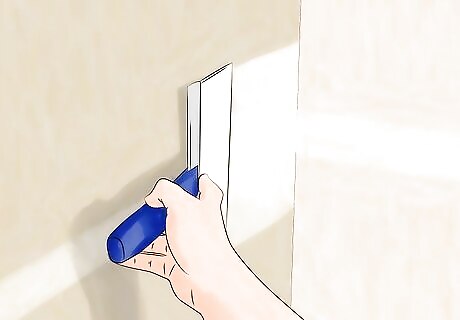
Use a 10- or 12-inch (25 cm or 30 cm) drywall knife to hit any tapered edges. Tapered edges are where two drywall edges meet, getting thinner as they meet. This creates a small void on the surface of the drywall. The good thing is that voids are easier to even out with compound than protrusions. Simply take a 10" or 12" drywall knife and run a thin piece of compound over the tapered joint in a straight line. Expect to finish tapered joints at around 10" to 12".
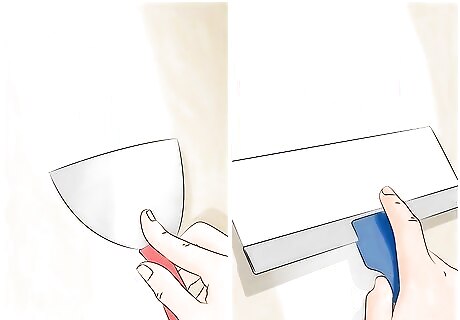
Use a smaller drywall knife and work your way up to 14-inch (35 cm) drywall knife to hit any butt joints. Whereas tapered joints are recessed edges, butt joints are protruding edges. Butt joints take more effort than tapered joints to conceal, because you have to thin out a protrusion instead of fill in a gap. Locate the center of the butt joint. On one side of the joint, start mudding with an 8" (20 cm) drywall knife. Gradually work your way up to a 14" drywall knife, hitting only one side of the butt joint. Starting with an 8" drywall knife and gradually working your way up, mud the opposite side of the butt joint. When you're done, you should have 24" to 28" (60 cm to 71 cm) of drywall compound, in one layer, across the length of the butt joint.
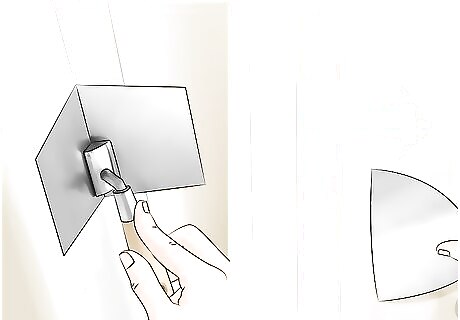
Use a 6-inch (15 cm) drywall knife to hit any corners. Use your drywall knife to finish one side of the corner only and let dry. Wait one day and then finish the other side of the corner with the same knife. If you try to finish both corners in the same day, you'll pull out compound on the opposite side when you push down with your knife in the corner. If you wish, you can use an inside corner tool instead of finishing each corner one by one. An inside corner tool is a drywall knife that's curved at a 90° angle in the middle, perfect for hitting inside corners. Using this tool, however, requires a little bit of skill.

Sand the second coat of joint compound. After 24 hours, sand it down gently to smooth it. Use a lightt-grit sandpaper, and do not sand too hard. You just want to smooth off a little bit of the coarse compound; you don't want to take the entire sheetrock cover off.
Applying the Third Coat of Compound
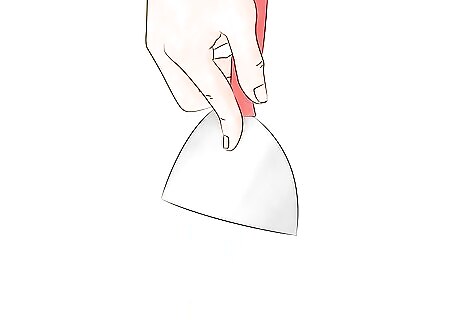
Start the day again by knocking off. With a small drywall knife, go over the previous day's compound and knock off any buildup or burrs that escaped the leveling effect of the drywall knife. 15 or 20 minutes of knocking off can make a huge difference in the final product.

Apply the third and final coat of joint compound. Without a third layer, you'll likely have areas where there's no compound and areas where the compound can be several layers deep (butt joints, for example). The texture on the drywall where there's no compound will look and feel different from drywall that has compound. A third coat of drywall will eliminate this, giving your entire wall the same, even texture.
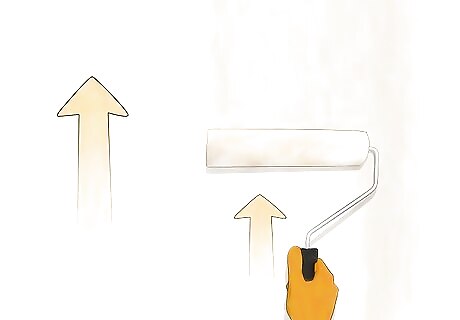
Apply a lightweight compound to the entire drywall with a 3/4-inch nap roller. Take your roller, dip it into the compound, and lightly start applying it onto the surface of the drywall, working in sections. You don't want the roller to roll as much as glide across the surface, distributing compound. When rolling the compound onto the drywall, start from the bottom and move upward. This way, your compound won't drip onto the floor. Be sure to work in manageable sections. You'll be removing most of the compound, so try work in small sections as to keep it from drying out before you have a chance to remove it. Put the compound on pretty heavy. If you put on compound on too thinly, it tends to dry out. This makes removing it harder, if not impossible.
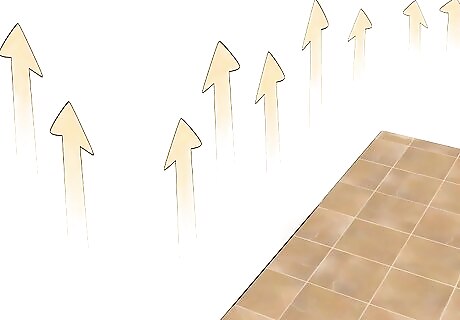
Avoid corners, but hit seams. The corners are already covered in compound, so there's little need to cake on extra compound where they are. The seams, however, you want to blend, so putting compound over them will help accomplish that.
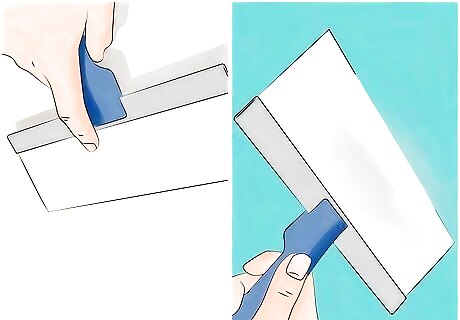
Remove as much compound as possible from the drywall, working in sections. With a larger drywall knife, scrape as much drywall compound from the wall as possible. You're not trying to get a plaster finish or a veneer plaster finish; you're simply trying to even out the texture of the drywall with a thin layer of compound.
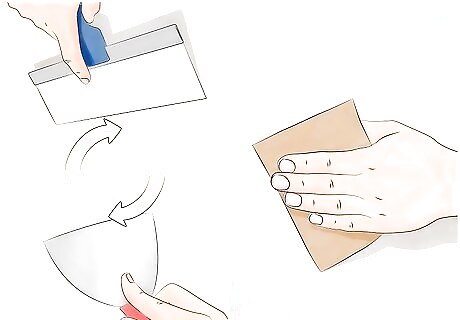
Continue applying compound, and then removing it, in sections. Cover and strip the entire wall in this method. Once completed, allow 24 hours for compound to dry, and then sand one final time to prep the drywall for priming.




















Comments
0 comment